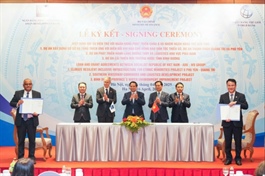Green capital: a strategy for sustainable development
Green capital: a strategy for sustainable development
Amid growing climate challenges, green finance is becoming a central pillar in economic policy. Pioneering economies like the EU, the United States, South Korea, and Japan are establishing robust legal frameworks and mobilising green capital to mitigate negative environmental impacts while fostering long-term growth momentum.

Vu Chi Cong, co-head, VinaCarbon VinaCapital |
Globally, the scale of the green finance market has surged in recent years. Total global climate and sustainability finance reached $5.87 trillion in 2024 and is expected to increase by approximately 20 per cent annually during 2025-2034.
According to the Climate Bonds Initiative, the world will require approximately $9 trillion annually this decade to transition to a low-carbon economy. Several countries have introduced notable policies to encourage green and sustainable finance. The European Union has committed $282.64 billion in green bonds under the Next Generation EU programme and established the EU Taxonomy classification standards to attract private capital in 2021. By late 2024, it had issued about 73.48 billion under this programme.
The US has invested $369 billion in clean energy through the 2022 Inflation Reduction Act. Since its enactment, substantial progress has been made across various sectors. South Korea has pledged a significant financial commitment to tackling climate change, announcing a $313 billion green financing plan. This initiative aims to slash greenhouse gas emissions by 40 per cent from 2018 levels by 2030. In addition, Japan plans to invest up to $1.1 trillion in clean energy and issue about $139.36 billion in climate transition bonds.
Vietnam, a country heavily affected by climate change, with losses estimated at 3.2 per cent of GDP annually, has set a goal of achieving net-zero emissions by 2050. To realise this target, Vietnam needs to mobilise approximately $368 billion, equivalent to 6.8 per cent of GDP per year, for green projects.
Since 2018, Vietnam has issued around $1.34 billion in green bonds, with pure green bonds totalling approximately $1.157 billion. Banks such as Vietcombank, BIDV, and HDBank, along with corporations like Vietnam Electricity, have taken the lead in raising capital for renewable and agriculture projects. However, market size remains modest, accounting for about 1.5 per cent of the total corporate bond market in 2024.
Regarding its legal framework, Vietnam issued a national strategy on green growth, setting clear targets such as reducing greenhouse gas emissions intensity per GDP by at least 15 per cent by 2030 and up to 30 per cent by 2050, compared to 2014 levels. Renewable energy is expected to account for 15-20 per cent of the total primary energy supply by 2030 and 25-30 per cent by 2050.
The State Bank of Vietnam (SBV) is also encouraging green banking, requiring commercial banks to integrate environmental risk assessments into credit activities and prioritise funding for green projects. The SBV expected green credit to account for 10 per cent of total outstanding loans by 2026 and rise to 25 per cent by 2030, reflecting the government’s strong commitment to advancing green growth. Despite a clearly defined strategy, Vietnam still lacks specific actions to accelerate the disbursement of green investments. To address this, Vietnam must tackle several significant challenges.
Firstly, Vietnam lacks a unified and clear green classification standard, which also known as taxonomy. This ambiguity leads to differing interpretations of green criteria among organisations, reducing policy implementation effectiveness, posing risks, and undermining investor confidence in green projects. Therefore, developing and issuing a national green taxonomy framework soon is essential.
Secondly, incentives for green projects remain unclear and insufficiently effective. While Vietnam offers incentives such as corporate income tax exemptions or preferential pricing for renewables projects, incentives for green financial investments are still vague and unattractive. In this regard, Vietnam could learn from Singapore and Hong Kong, which provide cost-support programmes for green bond issuance, or from Europe, with tax incentives, low-interest loan support, and the establishment of large-scale green transition funds.
For example, the Monetary Authority of Singapore has implemented the Sustainable Bond Grant Scheme, reimbursing about $92,800 in costs for hiring independent consultants to verify green bonds against international standards.
Additionally, a major challenge for Vietnam is the shortage of high-quality human resources in green finance. While many Vietnamese banks and businesses have begun focusing on environmental, social, and governance and sustainable finance, the number of adequately trained personnel remains limited.
In March, the Singapore Management University launched an online sustainable finance training programme tailored for the Vietnamese market. Organisations such as the Vietnam Banks Association and the International Finance Corporation have also organised short-term training courses to enhance awareness and skills for bank staff.
To improve the quality and capacity of personnel, Vietnam needs comprehensive solutions, such as integrating green finance into university curricula, expanding on-site short-term training programmes, and encouraging global certification. Furthermore, Vietnam should strengthen international cooperation to build a robust workforce in this field.
- 11:50 17/04/2025























